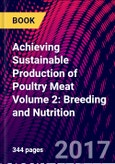To meet growing demand, the FAO has estimated that world poultry production needs to grow by 2-3% per year to 2030. Much of the increase in output already achieved has been as a result of improvements in commercial breeds combined with rearing in more intensive production systems. However, more intensive systems have increased the risk of transmission of animal diseases and zoonoses. Consumer expectations of sensory and nutritional quality have never been higher. At the same time consumers are more concerned about the environmental impact of poultry production as well as animal welfare. Drawing on an international range of expertise, this book reviews research on poultry breeding and nutrition. The first part of the book reviews how advances in genetics have impacted developments in breeding. Part 2 discusses ways of optimising poultry nutrition to ensure quality and sustainability in poultry meat production. Chapters review the use of feedstuffs and ingredients such as amino acids, enzymes and probiotics as well as feed formulation and safety. Achieving sustainable production of poultry meat Volume 2: Breeding and nutrition will be a standard reference for poultry and food scientists in universities, government and other research centres and companies involved in poultry production. It is accompanied by two further volumes which review safety, quality and sustainability as well as poultry health and welfare.
Audience: Academic researchers in poultry science; Government agencies responsible for food safety/quality and poultry farming; Poultry and egg processors
Audience: Academic researchers in poultry science; Government agencies responsible for food safety/quality and poultry farming; Poultry and egg processors
Table of Contents
Part 1 Genetics and breeding1. Genes associated with functional traits in poultry: implications for sustainable genetic improvement: Samuel E. Aggrey, University of Georgia, USA; Fernando González-Cerón, Chapingo Autonomous University, Mexico; and Romdhane Rekaya, University of Georgia, USA
2. A balanced approach to commercial poultry breeding: Nicholas B. Anthony, University of Arkansas, USA
3. Marker-assisted selection in poultry: P. M. Hocking and J. Hickey, University of Edinburgh, UK Part 2 Animal nutrition
4. The cellular basis of feed efficiency in poultry muscle: mitochondria and nucleic acid metabolism: Walter Bottje and Byung-Whi Kong, University of Arkansas, USA
5. Understanding feed and water intake in poultry: Sami Dridi, University of Arkansas, USA
6. Advances and future directions in poultry feeding:an overview: Velmurugu Ravindran and Mohammad R. Abdollahi, Massey University, New Zealand
7. Advances in understanding and improving the role of amino acids in poultry nutrition: William A. Dozier, III, Auburn University, USA and Paul B. Tillman, Poultry Technical Nutrition Services, Georgia, USA
8. Advances in understanding and improving the role of enzymes in poultry nutrition: Bogdan A. Slominski, University of Manitoba, Canada
9. Advances in understanding the role of phytate in phosphorus and calcium nutrition of poultry: Markus Rodehutscord, University of Hohenheim, Germany
10. Probiotics, prebiotics and other feed additives to improve gut function and immunity in poultry: Robert Moore, RMIT University, Australia
11. Using models to optimise poultry nutrition: R. M. Gous and C. Fisher, University of KwaZulu-Natal and EFG Software, South Africa
12. Developments in feed technology to improve poultry nutrition: Charles Stark, Kansas State University, USA; and Adam Fahrenholz, North Carolina State University, USA
13. Alternative sources of protein for poultry nutrition: Paul A. Iji, Mehdi Toghyani, Emmanuel U. Ahiwe and Apeh A. Omede, University of New England, Australia
14. Maintaining the safety of poultry feed: G. Raj Murugesan and Chasity M. Pender, BIOMIN America Inc., USA
15. Thermal adaptation and tolerance of poultry: Shlomo Yahav, Institute of Animal Science, ARO, Israel








